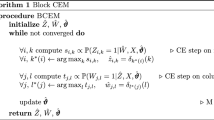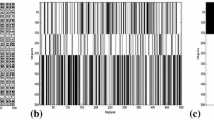Abstract
Co-clustering is known to be a very powerful and efficient approach in unsupervised learning because of its ability to partition data based on both the observations and the variables of a given dataset. However, in high-dimensional context co-clustering methods may fail to provide a meaningful result due to the presence of noisy and/or irrelevant features. In this paper, we tackle this issue by proposing a novel co-clustering model which assumes the existence of a noise cluster, that contains all irrelevant features. A variational expectation-maximization-based algorithm is derived for this task, where the automatic variable selection as well as the joint clustering of objects and variables are achieved via a Bayesian framework. Experimental results on synthetic datasets show the efficiency of our model in the context of high-dimensional noisy data. Finally, we highlight the interest of the approach on two real datasets which goal is to study genetic diversity across the world.









Similar content being viewed by others
Notes
The datasets can be found here: https://github.com/laclauc/NFLB and the code will be available upon publication.
References
Baudry JP, Celeux G, Marin JM (2008) Selecting models focussing on the modeller purpose. In: COMPSTAT 2008, Springer, pp 337–348
Ben-David S, Haghtalab N (2014) Clustering in the presence of background noise. In: Proceedings of ICML, pp 280–288
Biernacki C, Celeux G, Govaert G (2000) Assessing a mixture model for clustering with the integrated completed likelihood. PAMI 22(7):719–725
Bouveyron C, Brunet-Saumard C (2014) Model-based clustering of high-dimensional data: a review. Comput Stat Data Anal 71:52–78
Brault V, Keribin C, Mariadassou M (2017) Consistency and asymptotic normality of latent blocks model estimators. arXiv preprint arXiv:1704.06629
Celeux G, Martin-Magniette ML, Maugis C, Raftery AE (2011) Letter to the editor: “a framework for feature selection in clustering”. J Am Stat Assoc 106:383
Cuesta-Albertos JA, Gordaliza A, Matràn C (1997) Trimmed \(k\)-means: an attempt to robustify quantizers. Ann Stat 25(2):553–576
Dave RN (1991) Characterization and detection of noise in clustering. Pattern Recognit Lett 12(11):657–664
Dave RN (1993) Robust fuzzy clustering algorithms. In: [Proceedings 1993] Second IEEE international conference on fuzzy systems, vol 2, pp 1281–1286
Ester M, Kriegel HP, Sander J, Xu X (1996) A density-based algorithm for discovering clusters a density-based algorithm for discovering clusters in large spatial databases with noise. In: Proceedings of KDD, AAAI Press, pp 226–231
Frühwirth-Schnatter S (2011) Dealing with label switching under model uncertainty. In: Mengersen KL, Robert CP, Titterington DM (eds) Mixtures: estimation and applications. Chap 10. Wiley, Hoboken, pp 213–239
García-Escudero LA, Gordaliza A, Matrán C, Mayo-Iscar A (2008) A general trimming approach to robust cluster analysis. Ann Stat 36(3):1324–1345
García-Escudero LA, Gordaliza A, Matrán C, Mayo-Iscar A (2010) A review of robust clustering methods. Adv Data Anal Classif 4(2):89–109
Govaert G, Nadif M (2003) Clustering with block mixture models. Pattern Recognit 36:463–473
Govaert G, Nadif M (2008) Block clustering with Bernoulli mixture models: comparison of different approaches. Comput Stat Data Anal 52(6):3233–3245
Govaert G, Nadif M (2013) Co-clustering. Wiley, Hoboken
Hartigan JA (1972) Direct clustering of a data matrix. J Am Stat Assoc 67(337):123–129
Hoffman MD, Blei DM, Wang C, Paisley J (2013) Stochastic variational inference. J Mach Learn Res 14(1):1303–1347
Keribin C, Brault V, Celeux G, Govaert G (2015) Estimation and selection for the latent block model on categorical data. Stat Comput 25(6):1201–1216
Law MHC, Figueiredo MAT, Jain AK (2004) Simultaneous feature selection and clustering using mixture models. IEEE Trans Pattern Anal Mach Intell 26:1154–1166
Li M, Zhang L (2008) Multinomial mixture model with feature selection for text clustering. Knowl Based Syst 21(7):704–708
Maugis C, Celeux G, Martin-Magniette ML (2009) Variable selection for clustering with gaussian mixture models. Biometrics 65(3):701–709
Mirkin BG (1996) Mathematical classification and clustering. Nonconvex optimization and its applications. Kluwer academic publishers, Dordrecht
Pan W, Shen X (2007) Penalized model-based clustering with application to variable selection. J Mach Learn Res 8:1145–1164
Patrikainen A, Meila M (2006) Comparing subspace clusterings. IEEE Trans Knowl Data Eng 18(7):902–916
Raftery AE, Dean N (2006) Variable selection for model-based clustering. J Am Stat Assoc 101:168–178
Robert V, Vasseur Y (2017) Comparing high dimensional partitions, with the co-clustering adjusted rand index. arXiv:1705.06760
Rosenberg NA, Pritchard JK, Weber JL, Cann HM, Kidd KK, Zhivotovsky LA, Feldman MW (2002) Genetic structure of human populations. Science 298(5602):2381–2385
Wang S, Zhu J (2008) Variable selection for model-based high-dimensional clustering and its application to microarray data. Biometrics 64(2):440–448
Wang S, Lewis CM, Jakobsson M, Ramachandran S, Ray N, Bedoya G, Rojas W, Parra MV, Molina JA, Gallo C, Mazzotti G, Poletti G, Hill K, Hurtado AM, Labuda D, Klitz W, Barrantes R, Bortolini MC, Salzano FM, Petzl-Erler ML, Tsuneto LT, Llop E, Rothhammer F, Excoffier L, Feldman MW, Rosenberg NA, Ruiz-Linares A (2007) Genetic variation and population structure in native Americans. PLoS Genet 3(11):e185
Wang X, Kabán A (2005) Finding uninformative features in binary data. Intell Data Eng Autom Learn IDEAL 2005:40–47
Wyse J, Friel N (2012) Block clustering with collapsed latent block models. Stat Comput 22(2):415–428
Wyse J, Friel N, Latouche P (2017) Inferring structure in bipartite networks using the latent blockmodel and exact ICL. Netw Sci 5(1):45–69. https://doi.org/10.1017/nws.2016.25
Zhou H, Pan W, Shen X (2009) Penalized model-based clustering with unconstrained covariance matrices. Electron J Stat 3:1473–1496
Author information
Authors and Affiliations
Corresponding author
Additional information
Responsible editor: Jesse Davis, Elisa Fromont, Derek Greene, Björn Bringmann.
Publisher's Note
Springer Nature remains neutral with regard to jurisdictional claims in published maps and institutional affiliations.
Rights and permissions
About this article
Cite this article
Laclau, C., Brault, V. Noise-free latent block model for high dimensional data. Data Min Knowl Disc 33, 446–473 (2019). https://doi.org/10.1007/s10618-018-0597-3
Received:
Accepted:
Published:
Issue Date:
DOI: https://doi.org/10.1007/s10618-018-0597-3




